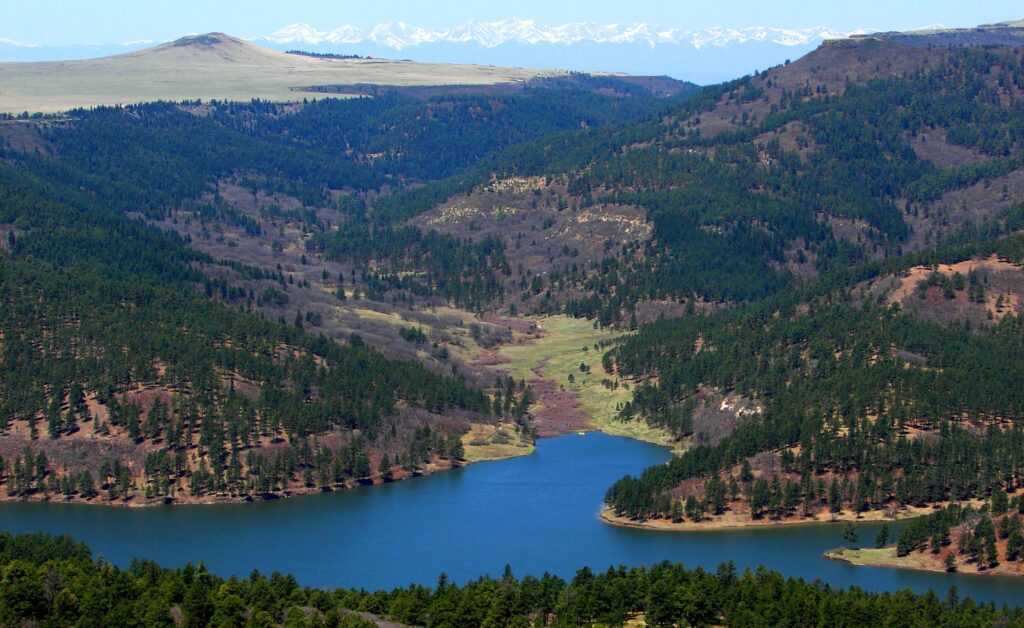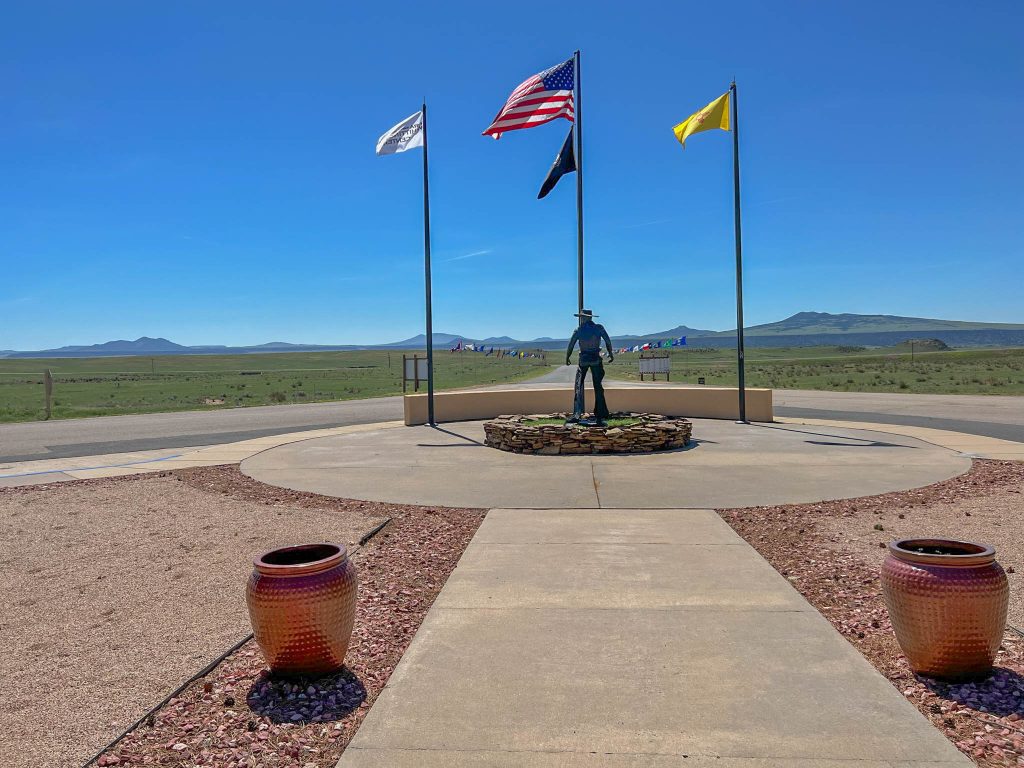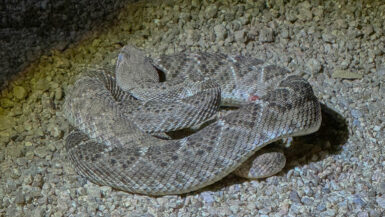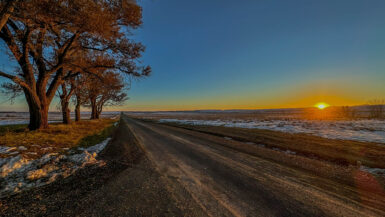Discover Raton, New Mexico—where dinosaur history, the Santa Fe Trail, biker rallies, a firearms museum, and green chile pizza all collide in one unforgettable high-plains town.
Just south of the Colorado border, Raton, New Mexico (population ~6,000) is a town that many travelers pass by without a second glance—often remembered only as “that last stop before Colorado.” But if you take the time to exit the highway, you’ll find a place that’s anything but forgettable. The city of Raton is layered—geologically, historically, and culturally. From ancient rock formations and traces of dinosaur-era extinction to top-notch pizza, a massive firearms range and museum, and a motorcycle rally that livens up the streets most summers, Raton is a town worth slowing down for.

Table of Contents
Raton: Forged by Fire, Trails, and Community
Raton may seem like a quiet stop on the map today, but its story begins with fire from the sky. Just outside of town, on Goat Hill, lies a visible slice of the Cretaceous–Paleogene boundary—a thin, unassuming band of rock laced with iridium, a rare metal more common in meteorites than on Earth. That little line marks the moment, 66 million years ago, when a massive space rock slammed into the planet and wiped out nearly three-quarters of all species, including most—but not all—dinosaurs.
A few hardy lineages made it through: feathered survivors that eventually became today’s birds, plus small mammals, crocs, turtles, frogs—and yes, even cockroaches. Turns out being small, adaptable, and not picky about food has its advantages when the world ends.
Fast forward about 66 million years, and Raton was once again at the center of dramatic change—this time, human-made. In the 1800s, the area became a vital corridor for traders on the Santa Fe Trail, a rough-and-ready route stretching from Missouri to New Mexico. Raton Pass, just outside town, was one of its most challenging and iconic segments. Travelers braved steep terrain, harsh weather, and the ever-present possibility of buffalo herds or bandits. Today, if you know where to look, you can still spot the faint tracks of wagon ruts etched into the landscape.
When the Atchison, Topeka and Santa Fe Railway arrived in 1880, Raton’s place in history was sealed. The town boomed as a hub for coal mining, ranching, and rail travel. Sturdy brick buildings rose downtown. The Santa Fe Trail gave way to steam engines, and the town became a melting pot of coal barons, rail workers, ranchers, and a few characters you wouldn’t want to meet in a dark saloon.


Even the name “Raton” carries a story—it’s Spanish for “mouse,” likely a reference to the jagged ridgelines of the nearby Raton Range, which early explorers thought resembled a mouse’s back. But before it was Raton, the area was known as Willow Springs, a natural stop along the Santa Fe Trail where travelers would rest and refill their water near a spring lined with willow trees. Over the decades, this little mountain town has welcomed wave after wave of fortune-seekers, from pioneers to railroad workers to geologists.
Today, Raton still carries the grit and spirit of its frontier past. Its historic downtown mixes weathered brick buildings with bold murals, offbeat shops, and plenty of green chile-smothered comfort food. Just outside town, you can hike through ancient lava flows at Sugarite Canyon, spot volcanic remnants, or follow the traces of travelers who rolled through in wagons long before the interstate.
Exploring Raton: Trails, Tales, and the Spirit of the Southwest
Sugarite Canyon State Park: Rugged Beauty on the Border
Just six miles northeast of Raton, Sugarite Canyon State Park offers a mix of forested slopes, meadows, and volcanic cliffs—spanning nearly 3,600 acres. Though the park is based in New Mexico, its northern boundary brushes up against Colorado, and trails near Lake Maloya briefly cross into the neighboring state. It’s one of the few places in the region where you can casually walk across a state line without even noticing.
The park features about 13 miles of hiking trails, ranging from short, family-friendly paths to more strenuous routes that climb into higher elevations. Lake Maloya and Lake Alice anchor the park’s recreational options, offering year-round opportunities for fishing, non-motorized boating, and wildlife viewing.
History buffs can explore the remnants of a 20th-century coal-mining camp, where interpretive signs and stone foundations offer a glimpse into the lives of those who once worked the canyon. Trails like the Ponderosa Ridge Trail reward hikers with sweeping views of the surrounding mesas, while quieter loops wind through shady pine and aspen groves.
At night, Sugarite’s dark skies make it a solid spot for stargazing. With both developed and primitive campsites available, it’s a worthwhile base for anyone looking to slow down and explore this less-traveled corner of northern New Mexico.

Run to Raton: Where Engines Roar and History Rumbles
Every summer since 2016, downtown Raton has typically shifted into high gear for Run to Raton—a multi-day motorcycle rally that blends custom bikes, live music, and community spirit. The event draws bikers, builders, and bands from across the region, featuring custom bike shows, tattoo artists, live music performances, and a variety of vendors.
However, there will be no Run to Raton in 2025. Organizers have announced a hiatus for this year.
Despite the cancellation, the spirit of the rally remains a part of Raton’s identity. Over the years, Run to Raton has grown into more than just a motorcycle event—it reflects the town’s sense of community and character. Locals and visitors alike have embraced its welcoming atmosphere, whether arriving on two wheels or simply stopping by for the music and camaraderie.
Set against the backdrop of the Raton Range and rooted in the history of the Santa Fe Trail, the rally has celebrated the town’s frontier spirit and love for the open road. While 2025 will be quieter, anticipation for future gatherings will no doubt continue to build among enthusiasts and community members.


NRA Whittington Center: Scenery, Shooting, and Southwestern History
After spending the night in the train depot Airbnb (featured earlier in this post), my son and I decided to check out the NRA Whittington Center, just south of Raton. I’d heard it was worth a visit, but I had no idea just how massive the place really is—it spans over 33,000 acres, making it one of the largest shooting and outdoor recreation facilities in the country. With 25 ranges covering everything from pistols and rifles to trap, skeet, and black powder, it draws everyone from Olympic hopefuls to weekend hobbyists.
The center is named in honor of George Raymond Whittington (1906–1983), a lifelong advocate for shooting sports who served as President of the National Rifle Association, as well as a sponsor, advisor, and national record holder. He devoted his life to advancing the sport at every level—local, state, and national—and was remembered by the Texas State Rifle Association as “a true friend in every sense of the word.”
But there’s more to it than firearms. The center includes landmark trails and walking paths that pass by historical features like Santa Fe Trail markers and the remains of the old Van Houten coal-mining town. They also host events like Hike to Hunt, where visitors trek through meadows and wooded terrain with archery gear in hand.
One of the main attractions—the Frank Brownell Museum of the Southwest—is currently closed for renovations, but it’s worth keeping on your radar. It’s the largest firearms museum in the region, and when it reopens, it’ll feature two massive “Gunquariums,” each measuring sixteen feet long by ten feet tall and three feet wide. Instead of fish, these oversized display cases will showcase over 200 long guns and 100 handguns in an immersive visual layout. Once reopened, the museum will remain free to the public.
Even if, like me, you’re not particularly into guns, the NRA Whittington Center is still a fascinating stop—unless you’re really not into firearms or taxidermy, in which case, you might want to pass. But for us, it was well worth it. Whether you’re there to shoot, explore, or just take in the surroundings, the Whittington Center is one of the most distinctive places you’ll find in the Raton area.





Bruno’s Pizza & Wings: Local Flavor Done Right
No trip to Raton is complete without a stop at Bruno’s Pizza & Wings. At least, that’s what my son insists—and after eating there, I’m not going to argue. This family-owned spot has been serving up wings and pizza since 2015, and their reputation stretches well beyond town limits. Apparently, their wings have even won awards here in New Mexico.
Naturally, I figured my wing-loving son would go straight for them. But he surprised me and went with a pepperoni pizza instead, reasoning that he was too hungry for anything that required napkins and patience. I followed suit, ordering a pepperoni and green chile combo—because when in New Mexico…
The verdict? Outstanding. Crisp crust, perfectly balanced toppings, and just enough heat from the chile to remind you where you are. Bruno’s isn’t just good for a small-town pizzeria—it’s genuinely some of the best pizza we’ve had anywhere in the state.


Vermejo: Where Conservation Meets Luxury in the High Plains
Just 40 miles west of Raton, Vermejo, a Ted Turner Reserve, spans over 550,000 acres of diverse landscapes—from alpine tundra to vast prairies. This expansive terrain is home to a rich array of wildlife, including elk, bison, black bears, and mountain lions.
Guests can immerse themselves in nature through activities like horseback riding across open fields, exploring historic charcoal kilns, or fly fishing for the native Rio Grande cutthroat trout. The reserve boasts 19 fishable lakes and over 30 miles of pristine streams, offering ample opportunities for anglers.
Accommodations range from cozy historic cottages to eco-conscious mountaintop lodges and even a restored turn-of-the-century mansion. But Vermejo isn’t just a luxury getaway—it’s also a leader in conservation, actively restoring native species and managing one of the world’s most genetically pure bison herds.
Whether you’re chasing adventure or craving solitude, Vermejo offers a rare blend of wilderness and comfort—if you’re willing to substantially lighten your wallet. I haven’t taken the plunge yet, but I plan to check it out at some point and will update this post with details once I do.
Final Thoughts on Raton
Raton doesn’t beg for attention, and that’s part of its appeal. From prehistoric impact craters to motorcycle rallies, this town is full of quiet surprises. Whether you’re drawn by the geology, the history, or just a good stretch of sky, Raton invites you to hit the brakes and stay a while. Sometimes the best stops are the ones you didn’t see coming.
Thought for the Week
This week, we’re tipping our helmet to the riders.
Most summers, Raton’s streets echo with engines and energy during Run to Raton—a rally that’s as much about connection as it is about chrome. Whether you ride a custom chopper or just show up for the music and green chile, you can feel the rhythm of the road running through this town.
While the rally doesn’t happen every year, the spirit of it lingers. And whether you’re riding into Raton or just passing someone who is, here are a few quotes that capture the freedom of two wheels and open skies—perfect for the high plains, the mountain passes, and those long stretches where the only thing louder than your engine is your thoughts.
“Sometimes it takes a whole tank of gas before you can think straight.”
“Only a biker knows why a dog sticks his head out the car window.”
“Four wheels move the body. Two wheels move the soul.”
— Anonymous
Something to keep in mind the next time you hear the rumble of pipes and wonder where they’re headed—or where they’ve been.
Thanks for reading and happy travels!

Mark (The New Mexico Travel Guy)
Mark Aspelin, The New Mexico Travel Guy (www.newmexicotravelguy.com), is a travel writer and author of two books who has enjoyed a wide variety of adventures in his travels to over 100 countries and all 50 U.S. States. His current project involves visiting EVERY town in his home state of New Mexico (there’s over 500 towns) and writing a story about each one. He’s on track to finish the project by his early-mid 100s. When not traveling, Mark lives as a recluse in the mountains outside of Albuquerque, New Mexico.




I agree with your pepperoni & green chili combo pizza.
Your mom sent me some 505 green chili green sauce. Wow!
After we make the move to TX, I hope we can get over to visit.
k&p
Looking forward to it!
After 35 years away, your well written article makes us want to once again visit the Raton area!
Thanks Jay, sounds like you’re overdue for a trip back to NM!